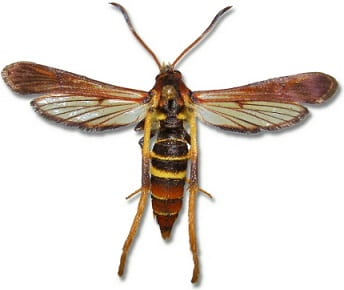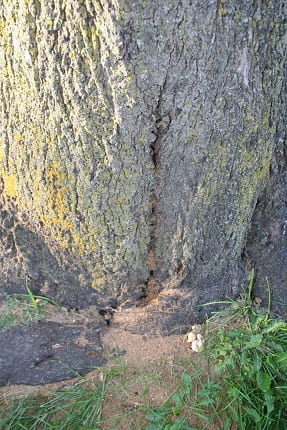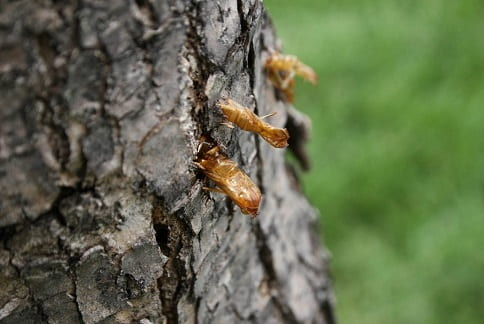–by Raymond Cloyd
Now is the time to take “action” to prevent damage from the ash/lilac borer (Podosesia syringae). Ash/lilac borer adults are typically active from late-April through June, although activity is contingent on temperature. Adults are brown, clearwing moths that look-like paper wasps (Figure 1). Adult females lay tan, oval-shaped eggs in cracks and crevices, or wounds at the base of plant stems. One female can live for approximately one week and lay up to 400 eggs. Below are nine points associated with the life history and management of ash/lilac borer:
Fig 1. AshLilac Borer Adult (Author–City of Edmonton)
- The larvae are responsible for causing plant damage by tunneling and feeding within the bark (cambium). Larvae can also tunnel further into the wood and feed within the sapwood and heartwood.
- Larval feeding restricts the flow of water and nutrients; thus resulting in shoot or branch dieback. Ash/lilac borer larvae feed at the base of plant stems causing swollen areas or cracks, and they also feed where major branches attach to the trunk.
- The presence of light-colored sawdust (frass) accumulating at the base of infected trees or shrubs (Figure 2) is evidence of larval feeding.
Fig 2. Sawdust Located At The Base Of An Infected Tree (Auth–Raymond Cloyd, KS)
- Ash/lilac borer overwinters as a late-instar larva located in feeding tunnels or galleries.
5. Trees or shrubs infested with ash/lilac borers will have brown papery pupal cases protruding from the bark (Figure 3), which is where adults emerge from.
Fig 3. Pupal Cases of AshLilac Borer Protruding From Tree Trunk (Auth–Raymond Cloyd, KSU)
- There is generally one generation per year in Kansas.
- The primary means of avoiding problems with ash/lilac borer is to avoid ‘plant stress’ by providing proper cultural practices including; irrigation (watering), fertilization, pruning, and mulching. In general, stressed plants are more susceptible to attack by ash/lilac borer than ‘healthy plants.’ A two to three foot wide mulched area around the base of trees and shrubs prevents injury from lawn mowers and weed-trimmers that can girdle trees and shrubs leading to ‘stress.’ Moreover, avoid pruning plants in late spring through early summer (under usual weather conditions) as this is when adults are typically present and the volatiles emitted from pruning cuts may attract adult females.
- Insecticides containing the active ingredients, permethrin, bifenthrin, or chlorantraniliprole can be applied to the bark—at least up to six feet from the base—to prevent ash/lilac borer larvae from entering which exposes them to insecticide sprays. Once larvae are inside the plant, they are not susceptible to insecticide sprays. Systemic insecticides applied to the soil or injected into trees or shrubs do not provide reliable control of the ash/lilac borer.
- Commercially available pheromone traps capture adult males, which help estimate when females will be laying eggs. Pheromone traps help appropriately time insecticide applications. Insecticide spray applications should begin seven to 10 days after capturing the first adults. Check pheromone traps two to three times per week for the presence of newly captured adult males.


